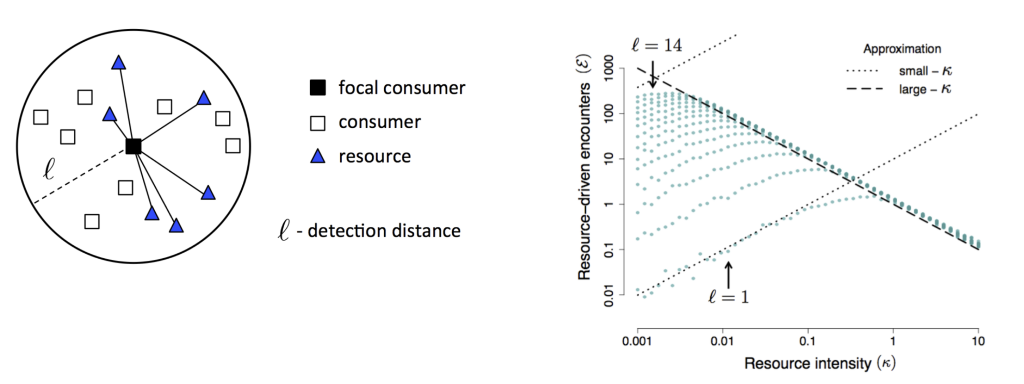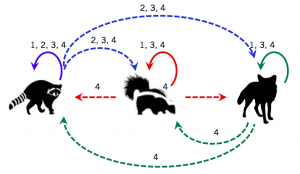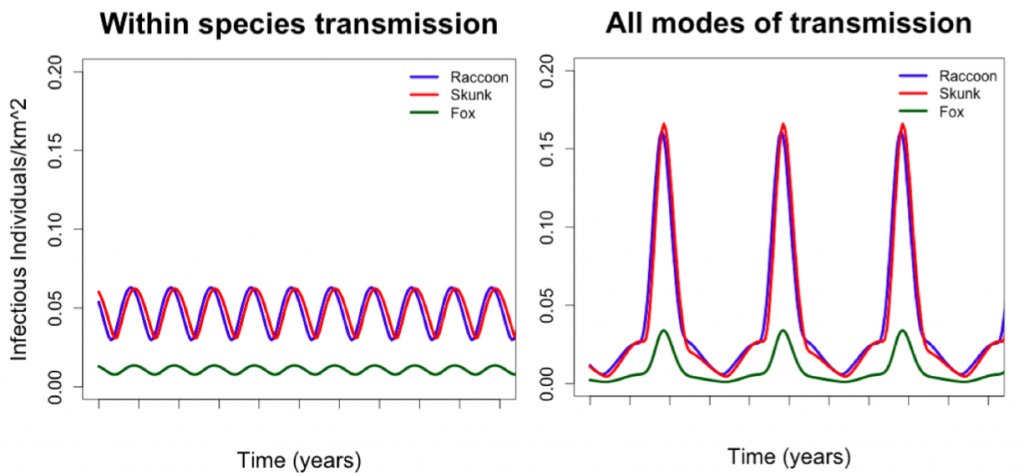Jackal rabies in Etosha National Park:
There are seasonal anthrax outbreaks in Etosha National Park. Local jackals opportunistically scavenge on the resulting carcasses. We use jackal position and carcass location data from the Berkeley Etosha Anthrax Project (PI: Wayne Getz) to investigate whether carcass abundance influences jackal encounter rates.
The abundance (or scarcity) of resources may influence consumer-consumer encounter rates.
Research Question:
How does resource abundance affect the risk of pathogen invasion? Specifically, how does carcass abundance affect the risk of a rabies epidemic in the population of jackals in ENP?
Methods:
We use spatial poisson processes to model the locations of consumers (jackals) and resources (carcasses) and assume there is a maximum distance of detection at which consumers are able to detect resources. Consumers choose the closest resource that they detect. We use a combination of simulations and asymptotic analysis to see how the consumer-consumer encounter rate at resource sites changes with resource density.
Figure 1: consumer-resource landscapes Figure 2: simulated resource-driven encounters
Whether or not a pathogen, such as rabies virus, is able to invade a population depends on the number of new infections an infectious individual produces on average during the time that individual is infectious. In order for an infection to occur, a susceptible individual must have contact with (encounter) an infectious individual. We assume that individuals experience a baseline level of contact (e.g. from interacting with neighbors at territory boundaries) and then add the resource-driven encounters to estimate the number of new infections an infectious individual produces.
Results:
We found that the relationship between resource abundance and resource-driven encounter rate is non-monotonic (see Figure 2). So, for different resource density and detection distance values, pathogen invasion in the jackal population could be driven either by an increase or decrease in carcass availability. Particularly when resources are rare, the distance at which consumers detect resources plays a major role in determining the expected number of resource-driven encounters.
Collaborators:
Steve Bellan, University of Texas at Austin
Jason Flynn
Scott McKinley, Tulane University
Juliet Pulliam, South African Center for Epidemiological Modeling and Analysis
Additional Data Sources and Supporters: Berkeley Etosha Anthrax Project (PI: Wayne Getz, Grant No. GM83863), Etosha Ecological Institute, Namibian Ministry of Environment and Tourism, Directorate of Parks, Wildlife and Management.
Rabies dynamics in small carnivores:
Currently raccoons are considered the only reservoir host in the northeastern United States responsible for rabies virus maintenance. Rebecca’s research investigates the alternative hypothesis that rabies transmission also occurs within fox and skunk populations. Mathematical models are developed to explore possible rabies transmission scenarios. Rebecca collaborates with researchers at the University of Florida, Centers for Disease Control and Prevention, and United States Department of Agriculture to inform and evaluate the mathematical models with surveillance data.
- Figure 3: possible transmission scenarios in small carnivore populations
1. Within species transmission
2. Only raccoon transmission
3. Within species transmission and raccoon spillover
4. All possible modes of transmission
Interestingly, different transmission scenarios can lead to qualitatively distinct disease dynamics. When there is only within species transmission, the number of infectious individuals cycles annually. In this case, the periodicity is determined by annual birth pulses (included in our model). However, when there is significant cross-species transmission, the period may no longer be annual. More investigation is needed to determine how different transmission rates influence the period of infectious individual cycles.
- Figure 4: ordinary differential equation model simulations

